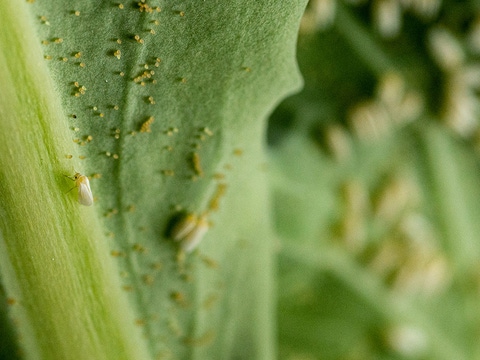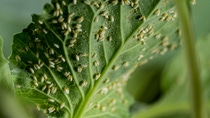“We developed Axalion with sustainability in mind and because of that, it can be used in food production practices that also use beneficial insects.”
Desirée Hodges, BASF Senior Research Scientist
Sustainable Innovations
that farmers need for
_opt.jpg)
Agriculture
Growers need insecticides that provide reliable control of pests without impacting beneficial insects used for biological control or pollination.
As head grower in the hydroponic greenhouses of P’Petual, a vegetable produce company based in Buckland Park in South Australia, Andrew Potter maintains 12-acres of climate-controlled oasis where eggplant, tomatoes and cucumbers thrive. But these perfect conditions often attract uninvited guests.
Tiny, white sap-sucking bugs called whiteflies find as much comfort in the warm and humid conditions of P’Petual’s greenhouses as the vegetables that Andrew is growing to put on grocery store shelves, and they eat the vegetables too. And that’s why whiteflies are a threat to the quality and quantity of harvest, especially difficult to control during their rapid reproduction cycles in the warmer months.
Researchers at BASF have been innovating these types of sustainable solutions for a long time. “Wherever farmers try to make their cultivation more sustainable, it is our responsibility to provide them with the tools and technology they need,” stresses Desirée Hodges, Senior Research Scientist Global Insecticides at BASF Agricultural Solutions based in Research Triangle Park (RTP), USA.
“We developed Axalion with sustainability in mind and because of that, it can be used in food production practices that also use beneficial insects.”
Desirée Hodges, BASF Senior Research Scientist
Axalion® Active Insecticide is one of the latest in-house innovations from the company, and Desirée has been on the team supporting its development from the beginning. “Of course, Axalion has the piercing and sucking insect control part covered,” she says.
The new insecticide active ingredient is known for its rapid and reliable control of whiteflies and other piercing and sucking pests that can be especially problematic for growers in greenhouse production.
Like many at BASF Agricultural Solutions, Desirée’s work is driven by her own love of farming. Desirée managed production in a greenhouse before working at BASF. “It’s important to me to be a part of making crop protection more sustainable and to contribute to new innovations that didn’t exist when I was a grower.” She adds, “Axalion is just one of these next generation of sustainable solutions that we are delivering to growers.
Available as Efficon® insecticide, Axalion Active was first introduced in Australia in 2023 and worked well for Andrew Potter. “We decided to try this new insecticide on our eggplants and found that it was a great addition to our IPM programs,” he says. “Axalion’s ability to control multiple stages of whitefly and bring down their numbers so that they are back in balance with our beneficial pest control makes it a perfect fit.”
Fruits and vegetables are labor-intensive, complex crops that must be in perfect shape and condition to appeal to consumers as fresh produce in supermarkets.
“Most people look at eggplant and think about dinner, but I’ve been a grower myself and know about the challenges farmers face while doing the biggest job on Earth,” Desirée says. “When I see fruit looking this great it always reminds me of the tremendous amount of effort and care that growers put into producing such exceptional quality produce. And I’m excited that growers around the globe are finding such great success with Axalion.”
Axalion is highly compatible with non-target organisms and beneficial insects, including predatory insects, when applied according to label instructions.
In 2024, Axalion was introduced to farmers in Korea and India, and it was recently registered in Brazil and Mexico. Additional registrations are expected to follow in various countries in Asia, Europe and South America for fruits, vegetables and row crops.
Over the course of the coming years, Axalion will be made available to even more farmers and growers so that their efforts to provide an oasis for crops are not lost on uninvited guests.
Published January 31, 2025 by Katie Lelito and Panagiota Boumpalou (BASF Global Agricultural Solutions).

